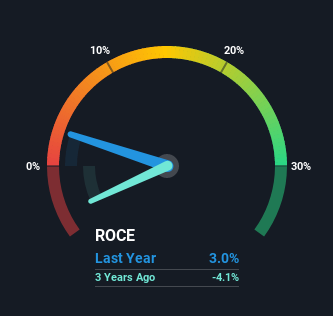If you're not sure where to start when looking for the next multi-bagger, there are a few key trends you should keep an eye out for. Firstly, we'd want to identify a growing return on capital employed (ROCE) and then alongside that, an ever-increasing base of capital employed. Ultimately, this demonstrates that it's a business that is reinvesting profits at increasing rates of return. So on that note, Questerre Energy (TSE:QEC) looks quite promising in regards to its trends of return on capital.
Understanding Return On Capital Employed (ROCE)
For those who don't know, ROCE is a measure of a company's yearly pre-tax profit (its return), relative to the capital employed in the business. To calculate this metric for Questerre Energy, this is the formula:
Return on Capital Employed = Earnings Before Interest and Tax (EBIT) ÷ (Total Assets - Current Liabilities)
0.03 = CA$5.5m ÷ (CA$193m - CA$13m) (Based on the trailing twelve months to September 2021).
Therefore, Questerre Energy has an ROCE of 3.0%. In absolute terms, that's a low return and it also under-performs the Oil and Gas industry average of 6.3%.
View our latest analysis for Questerre Energy

Historical performance is a great place to start when researching a stock so above you can see the gauge for Questerre Energy's ROCE against it's prior returns. If you want to delve into the historical earnings, revenue and cash flow of Questerre Energy, check out these free graphs here.
What Does the ROCE Trend For Questerre Energy Tell Us?
Questerre Energy has recently broken into profitability so their prior investments seem to be paying off. About five years ago the company was generating losses but things have turned around because it's now earning 3.0% on its capital. In addition to that, Questerre Energy is employing 31% more capital than previously which is expected of a company that's trying to break into profitability. This can indicate that there's plenty of opportunities to invest capital internally and at ever higher rates, both common traits of a multi-bagger.
On a related note, the company's ratio of current liabilities to total assets has decreased to 6.6%, which basically reduces it's funding from the likes of short-term creditors or suppliers. Therefore we can rest assured that the growth in ROCE is a result of the business' fundamental improvements, rather than a cooking class featuring this company's books.
What We Can Learn From Questerre Energy's ROCE
To the delight of most shareholders, Questerre Energy has now broken into profitability. Astute investors may have an opportunity here because the stock has declined 62% in the last five years. That being the case, research into the company's current valuation metrics and future prospects seems fitting.
On a separate note, we've found 1 warning sign for Questerre Energy you'll probably want to know about.
While Questerre Energy may not currently earn the highest returns, we've compiled a list of companies that currently earn more than 25% return on equity. Check out this free list here.
Valuation is complex, but we're here to simplify it.
Discover if Questerre Energy might be undervalued or overvalued with our detailed analysis, featuring fair value estimates, potential risks, dividends, insider trades, and its financial condition.
Access Free AnalysisHave feedback on this article? Concerned about the content? Get in touch with us directly. Alternatively, email editorial-team (at) simplywallst.com.
This article by Simply Wall St is general in nature. We provide commentary based on historical data and analyst forecasts only using an unbiased methodology and our articles are not intended to be financial advice. It does not constitute a recommendation to buy or sell any stock, and does not take account of your objectives, or your financial situation. We aim to bring you long-term focused analysis driven by fundamental data. Note that our analysis may not factor in the latest price-sensitive company announcements or qualitative material. Simply Wall St has no position in any stocks mentioned.
About TSX:QEC
Questerre Energy
An energy technology and innovation company, engages in the acquisition, exploration, and development non-conventional oil and gas projects in Canada.
Imperfect balance sheet with minimal risk.
Market Insights
Community Narratives


Recently Updated Narratives


MINISO's fair value is projected at 26.69 with an anticipated PE ratio shift of 20x


Fiverr International will transform the freelance industry with AI-powered growth

Constellation Energy Dividends and Growth
Popular Narratives


MicroVision will explode future revenue by 380.37% with a vision towards success


NVDA: Expanding AI Demand Will Drive Major Data Center Investments Through 2026



